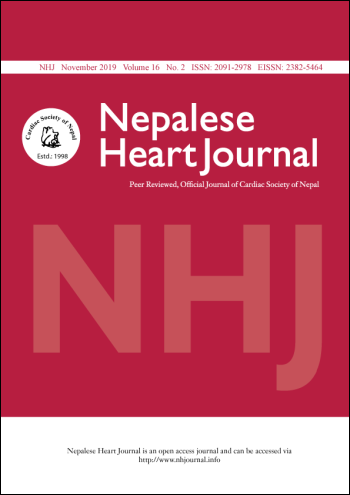Association of Carotid Intima Media Thickness with the severity of Coronary Artery Disease in patients undergoing Coronary Artery Bypass Graft Surgery in a tertiary care center
DOI:
https://doi.org/10.3126/njh.v16i2.26315Keywords:
Carotid intima media thickness, Carotid plaque, Coronary artery bypass graft, Coronary artery diseaseAbstract
Background and Aims: Atherosclerosis is an inflammatory process involving arteries in various organs. Carotid intima medial thickness (CIMT) can be useful noninvasive tool to detect atherosclerosis for diagnosis of significant cardiovascular disease. We aim to study the association of CIMT with severity of Coronary Artery Disease (CAD).
Methods: This was a cross sectional, observational study conducted in 81 patients with mean age of 59.9± 8.5 years with a diagnosis of CAD undergoing coronary artery bypass graft (CABG) surgery. The CIMT was measured with B-mode ultrasound in all patients and association with severity of CAD was measured.
Results: The prevalence of increased CIMT in our study group was 31% and carotid plaque was 69%. Presence of carotid plaque was significantly associated with severe grade CAD stenosis (t = 4, p < 0.001) and presence of Chronic Total Occlusion (CTO) (p = 0.028). There was no significant correlation between mean CIMT and severity of CAD expressed as mean percentage stenosis (r = 0.179, p = 0.11) but patients with CTO had higher mean CIMT value than non-CTO group (0.86 ± 0.21 Vs 0.73 ± 0.18; p = 0.027). We found that diabetic population had greater mean CIMT values than nondiabetic population (0.82 ± 0.21 Vs 0.72 ± 0.17; p = 0.017) and higher prevalence of carotid plaque (p = 0.02). Similarly, females were more likely to have increased CIMT than males (p=0.004).
Conclusion: We found that increased CIMT was associated with presence of CTO. Presence of carotid plaque was associated with severe grading of CAD and CTO. Carotid ultrasound can be useful noninvasive modality to predict presence of significant CAD.
Downloads
Downloads
Published
How to Cite
Issue
Section
License
This license enables reusers to distribute, remix, adapt, and build upon the material in any medium or format, so long as attribution is given to the creator. The license allows for commercial use.




